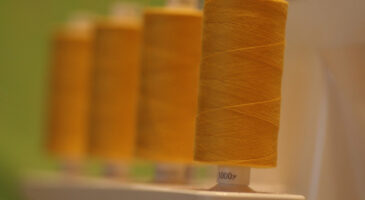In quilting, knowing how to finish your project is as important as understanding every other step involved, right from the start of the project to the very end. When you finish your quilting work the right way, it adds a professional touch to the overall look of the project and makes them appear rather appealing.
One of the several ways quilters use for finishing their project is binding which involves the use of fabric strips to create a border or frame at the edges of the quilt. The fabric used for this borderline or frame is known as Binding fabric, yet, many people still don’t know what is binding fabric in quilting.

You will learn all you have to know about binding fabric in this helpful article and some other closely related questions.
What is binding in quilting?
Binding is a technique used in finishing quilting works, and it involves using fabric strip, which is usually double-folded. This double-folded strip is then wrapped and sewn to create a frame around the raw edges of a quilt.
Can I bind my hand quilt before quilting?
No, you can’t bind your hand quilt before quilting. Binding is the final stage in quilting, and there’s no way you can bind your quilt unless you are at the final stage. That is, before binding, you must have joined the front, back, and batting of the quilt.
Can I bind the edge of my quilt before quilting?
This answer is in two folds, and therefore, it can be hard to say yes or no. Binding as a quilting process is ordinarily meant to come at the final stage of the project. But there are instances where quilters prefer to do their binding before they finish their project. If you know how this can be done without affecting your project in any way, then there’s no problem in trying.
But my token would be that you stick to the regular way of completing your project with a binding fabric.
What is the difference between binding and facing?
Both binding and facing are the same in their uses; they are both used to neaten or secure the raw edges of a quilt. However, they are different in the sense that both sides of bindings are visible, while facings can only be visible on one side, either the wrong or the right side.
Is binding necessary for quilting?
Yes, binding is an essential step in quilting. Even though binding is, yes, the last stage in quilting, it is as important as every other stage involved in quilt making and hence cannot be skipped. Binding helps to secure the raw edges of the top, backing, and batting of the quilt, so they don’t come undone after some time. Asides from the protective purpose, if the binding fabric is carefully selected, it can add extra color or appeal to your final product.
Why do quilts need binding?
- It helps to secure threads around the quilt edges so that they don’t unravel
- It helps to finish the edges of a quilt and make it ready for use.
- They make washing easy as there are usually no concerns about fraying or batting sticking out when a quilt is bound.
How to measure fabric for quilt binding
- Add twice the length and twice the width of the quilt together to get the perimeter, and then add 10 inches to give the yardage of fabric you will need for binding in inches. For instance, if the length of the quit is 90 and the width is 90.
This means you will have something like 2×90 + 2×85 + 10 = 180 + 180 + 10″ = 360″
- Once you’ve arrived at your yardage, divide the figure by 40, which in this illustration is 350, to give you the number of strip binding you will require for your project. That is 360 ÷ 40 = 9. This means you will have to cut 9 strips of binding for this project.
- Multiply 9, which in this case is the number of strips by the width of the strip, which is usually 2 and a half. To get half a yard if you are working with a yard, just divide the number by 36 and if you are working with a meter instead, divide the number by 39.
How to make quilt binding from fabric
Majorly there are 3 different ways you can make quilt binding from fabric, and they are as follows.
- Cross grain strips: this type of strip is cut across the fabric width from selvage to selvage.
- Lengthwise strip: this kind of strip is cut along the fabric length and parallel to the selvages.
- Bias strips: this type of strip is diagonally cut across the fabric.
The bias strip is more suitable for curved edges, while the other two can be used to bind another edge style so long the edges are not curved or bent.
How do I bind a quilt for beginners?
- The first step in binding quilting is calculating how many strips you will need for your project (check the previous section for instructions on how to measure).
- Next will be sewing the binding by placing the right side of two strips together at a 90° angle and sewing at a 45° angle.
- Press the wrong side of the binding with iron along the whole length.
- All excess backing and batting should be trimmed off, then attach the binding to the quilt.
- Secure the binding with clover wonder clips at the back of the it and hand stitch down.
Lastly, hand stitches the binding on the back with needle and thread.



